Genre: Puzzle Developer: Probe Software Publisher: Sega Europe Players: 1 Released: 1992
Even veritably rock stars need to start small. These days, Rockstar Games is one of the biggest and most successful game studios in existence, mainly thanks to its incredibly successful Grand Theft Auto franchise. The main entries in this series still originate from the subsidiary where they all started, the Scotland-based development house Rockstar North. What many of the younger gamers, who grew up with the wholly fleshed out 3D sandbox worlds of the GTA games, don’t remember is that Rockstar North was originally known under a wholly different name: DMA Design. Founded in 1988, this little Dundee-based studio mainly developed games for home computers like the Amiga or PCs. Most of its games were released by now defunct British game publisher Psygnosis. This doesn’t mean that it didn’t hit it big until Rockstar and the GTA series came along, however. In fact, one of its earliest titles was such a huge success that its name should be deeply ingrained in the brains of every gamer worth his salt.
Along with names like Tetris and Prince of Persia, it remains one of the most widely ported games to this day, selling – differing from source to source - between 15 to 21 million copies on over two dozen different gaming platforms. Additionally, there are many more unofficial ports as well. There’s even a version for HP48 graphic calculators out there. Needless to say, after its original release in 1991, it was ported to almost every other computer and console available in its day, and since the Master System still had some modicum of success in Europe and Brazil, these two regions also received their very own version of it. If you glanced at the top of the page you already know what I’m talking about: Lemmings, the original puzzle game where you need to save a handful of critters from obliviously walking into their certain doom.
For the few of you who like to hang around reading reviews for old gaming consoles but somehow never heard of this game, here’s a little synopsis. Lemmings is a real-time puzzle game. In each level, the eponymous blue-clad, greenhaired critters are released into the stage and immediately start walking from right to left. If they hit upon an obstacle, they turn around, but otherwise they obliviously run into fire, water, pitfalls, and other devious traps, getting obliterated in the process. It’s your job to guide at least a requisite minimum number of Lemmings safely to the exit. In order to do so, you can equip each Lemming with certain abilities that may help them overcome obstacles. In all, there are eight abilities: climbers can scale vertical walls, floaters can safely fall from great heights, builders can make bridges with up to twelve steps diagonally upwards, bashers can smash horizontally through obstacles, diggers do the same on a vertical scale, miners pave paths leading diagonally downwards through the ground, blockers stand still and make other Lemmings turn around, and bombers blow themselves up after a five-second countdown. Why would you want to do that? Well, that’s because you don’t always have every tool at hand in every single level If you need to get past an obstacle but don’t have a basher or a digger, a well-timed suicidal explosion may be necessary to clear the way. There is also an option to nuke every Lemming onscreen at once, allowing you to restart if you get stuck (plus, it’s kind of hilarious to watch). Also, every level has a time limit, and in the tougher stages, this puts you under no small amount of pressure. In order to solve levels later on, you need to get a great feel for the resources at hand, the mechanics and their idiosyncrasies: How far can a Lemming drop before he falls to his death? When do I have to start laying a bridge if I want to cross a gap with as few builders as possible? Is there a way to get a blocker moving again? (Yes, there is!). When does my miner have to start digging his tunnel if I want to break through a wall just where I need him to?
The game was originally conceived for 16-bit platforms, so by bringing the Lemmings to an 8-bit system, the guys at Probe Software who were tasked with the port had to make a few sacrifices. While the core gameplay remains intact for the most part, there are a few noticeable changes. Gone are the 20 two-player stages; even though the main screen teases you with a field that reads “one player” it cannot be set to two. Unlike the Genesis version (where Sunsoft handled the port), the Master System edition didn’t receive an extra package on top of the 120 original levels taken from the Oh No! More Lemmings expansion set but retains the structure of four difficulty categories (Fun, Tricky, Taxing and Mayhem) containing 30 stages each. That isn’t to say that this version doesn’t have any unique stages of its own though. A few of the original ones most notably the five stages that used graphics and audio assets from other Psygnosis games like Shadow of the Beast, Beast II or DMA’s own Menace were removed from the game. In their stead, however, are a handful of unique levels that exist only on the Master System, including five “SEGA stages” with their own assets and prominently placed SEGA logos. Also, in order to ease the strain on the console, no more than 20 Lemmings are released into each stage, which changes a few strategies here and there. So even if you’re a Veteran Lemmings player, there is something in here that is worth checking out.
Graphically, the game remains surprisingly intact. Traps don’t have as many frames of animation to them as in the 16bit versions and don’t look as gory when the poor critters fall victim to them. Also, when Lemmings explode, they don’t do so in a shower of pixels but rather in a moderate (but still kind of funny to watch) bang. Other than that, the graphics look very similar to the original, which is a bit impressive. Okay, the background remains black and featureless in every single level, but that’s something Lemming veterans have gotten used to a very long time ago.
The audio is pretty good, which comes to little surprise as the music for this port was done by none other than Matt Furniss, one of the major console game composers from Europe. While most tracks have been recreated from the originals and include many classic samples, there are also a few original compositions exclusive to this version in there. Relevant audio cues like the clinking sounds when the builder is running out of blocks, the encouraging “Let’s Go!” when a level starts or the exasperated “Oh No!” when a Lemming blows up, are all present as well.
As for the gameplay, well, here’s where platform shows its age. As already mentioned, the number of Lemmings released into each stage has been greatly reduced. Whereas some stages in the Mega Drive version could contain up to 100 of the critters, the Master System can only hold 20 at most. That’s still more than the mere 14 the NES had to offer, but it does necessitate quite a few changes in level layout and planning strategies. However, the system doesn’t even handle that number all that well: Once there are about 14 or more Lemmings in the level, the game starts to slow down noticeably. This can become problematic, especially in later stages where timing is of great importance.
Since the levels are usually larger than the screen area you have to scroll around quite a bit, which unfortunately is a bit jerky as well. Also, there is no map screen in the game, which makes it hard to keep track of every individual Lemming. This can make some stages very tricky to handle, especially in the later Taxing and Mayhem categories, where you have to pull off several tasks simultaneously in different areas. To offset this, starting the game with the one button instead of button two on your controller allows you to preview the stage without releasing any Lemmings until you press another button, which allows you to familiarize yourself with the layout. Also, by pressing pause on your Master System console you can freeze time while still being able to move your cursor, allowing you to plan ahead. You can’t assign new skills to Lemmings while in pause mode, but you can select a new ability and prepare it before you resume the game; however, since the pause button is located on the console itself, this manner is rather cumbersome. Why they didn’t assign the function to the one button on your controller, which is never used other than for previewing the stages, I don’t know. So, when playing on a console, you need to make sure you have the hardware in arm’s reach so you can readily apply the much-needed strategy. Needless to say, this makes it easier to play on an emulator, where you can assign the pause function to any key or button you like, than on the original hardware.
Seeing how the Master System was starting to show its age, it’s remarkable how much of the game remained intact. With 120 levels, including a few unique to this version, there is a lot on hand for strategic puzzle game fans. The sound is great and the graphics have suffered remarkably little for a downgrade from the 16-bit original. However, the noticeable slowdown, the lack of a map screen and the cumbersome pausing function on original hardware are detrimental to the overall fun. Once you get a hand on these issues though, you get to enjoy one of the best 8-bit renditions of this true classic. The premise may have aged a little, but that doesn’t make it any less of a brainteaser, even though modern gamers may be used to a little more action in their games nowadays.
Score: 7 out of 10

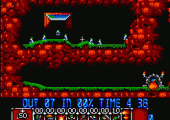
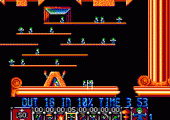
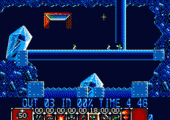
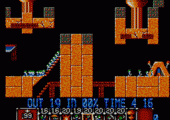
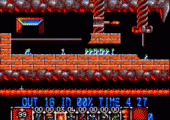
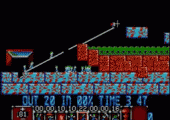
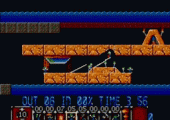
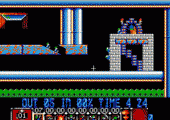

Recent Comments